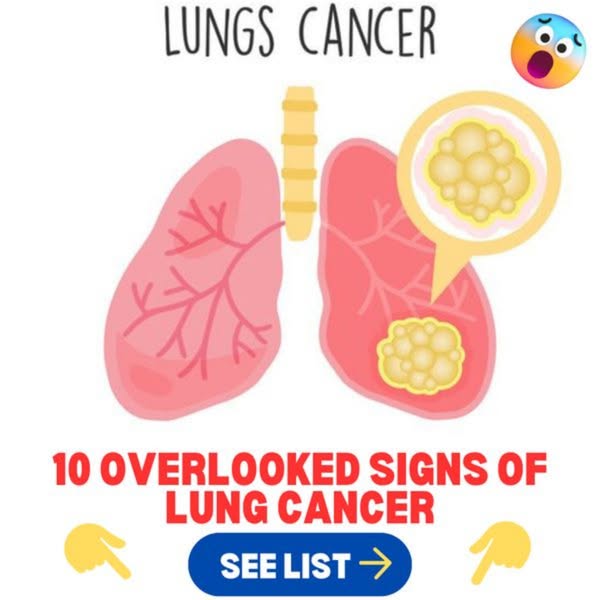Lung cancer is one of the leading causes of cancer-related deaths worldwide. Despite advancements in diagnosis and treatment, the survival rate remains low, mainly due to late detection. Many people miss the early signs, often mistaking them for minor or temporary health issues. Being aware of these often-overlooked symptoms is crucial for early diagnosis and better treatment outcomes.
Below are 10 subtle signs that may indicate lung cancer, along with helpful tips on what to look out for. If any of these symptoms feel familiar, don’t delay—consult a doctor promptly. Early detection can make a life-saving difference.
1. Persistent Cough

A cough that lingers for more than 2–3 weeks should not be ignored. Unlike a cold-related cough, this one may be dry or produce bloody or rust-colored mucus.
This occurs because tumors irritate the airways, causing chronic coughing. It may get worse at night or during physical activity. Monitor any changes in your coughing pattern—especially if it becomes more frequent or severe.
2. Shortness of Breath

Feeling short of breath after minimal exertion could be a warning sign. Lung tumors can narrow airways or lead to pleural effusion (fluid around the lungs), making breathing more difficult.
People often dismiss this as aging or poor fitness, but if you’re gasping for air during routine activities, it’s time to seek medical advice.
3. Chest Pain

Unexplained chest pain—whether sharp, dull, or constant—that worsens when breathing deeply, coughing, or laughing may be a sign of lung cancer.
This pain can occur when tumors press on nerves or the lining of the lungs. If chest pain persists, especially alongside other symptoms like coughing or breathlessness, consult a healthcare provider.
4. Unexplained Weight Loss

Losing weight without trying can seem like a positive change, but it may be a warning sign. Cancer cells consume energy, causing sudden or rapid weight loss.
Dropping several pounds quickly without changes to your diet or exercise routine is not normal—this warrants a thorough medical check-up.
5. Fatigue

Unlike regular tiredness, cancer-related fatigue is constant, severe, and doesn’t improve with rest or sleep. It can significantly impact your daily life.
In lung cancer, this is due to the disease’s effects on oxygen levels and energy metabolism. If you’re still exhausted after a full night’s sleep, speak with your doctor.
6. Hoarseness or Voice Changes

A hoarse voice or any change in vocal tone lasting more than a few weeks could signal trouble. Lung cancer can affect nerves that control the vocal cords.
Though often mistaken for laryngitis or allergies, persistent hoarseness deserves medical attention—especially if it doesn’t resolve on its own.
7. Frequent Infections

Recurring respiratory infections, such as bronchitis or pneumonia, may result from tumors blocking airways, trapping bacteria and viruses.
Frequent illness or slow recovery from infections could point to an underlying lung issue and should not be overlooked.
8. Swelling in the Face or Neck

Swelling in the face, neck, or even upper chest may be due to a tumor pressing on the superior vena cava, a large vein returning blood to the heart.
This condition, known as superior vena cava syndrome, can lead to redness, visible veins, and significant discomfort. Though rare, it requires immediate medical attention.
9. Shoulder Pain

While usually linked to injury or arthritis, unexplained shoulder pain could indicate a tumor in the upper lung (Pancoast tumor) pressing on nearby nerves.
This pain often appears without a clear cause and may get worse at night or when lying down. Don’t ignore shoulder pain that seems unusual or persistent.
10. Clubbing of Fingers

Clubbing refers to the rounding or swelling of the fingertips, often accompanied by softening of the nail beds. It is usually a sign of chronic low oxygen levels, which may be linked to lung cancer.
Though painless, clubbing can signal serious underlying health issues and should be evaluated by a healthcare professional.
Tips for Early Detection
Pay Attention to Your Body
The early signs of lung cancer can be easy to miss. Don’t ignore small changes, especially if you experience multiple symptoms together.
Know Your Risk Factors
Smoking, exposure to secondhand smoke, or contact with harmful substances like asbestos or radon significantly raise your risk. If you’re in a high-risk group, consider regular screenings.
Get a Second Opinion
If symptoms persist and the cause remains unclear, don’t hesitate to consult another doctor. An early diagnosis improves the chance of successful treatment.
Conclusion
Lung cancer is a serious illness, but early detection saves lives. Recognizing subtle, overlooked signs—like a persistent cough, shortness of breath, or unexplained weight loss—can lead to earlier treatment and better outcomes.
Stay proactive, stay informed, and most importantly, listen to your body. Your health is your greatest asset—don’t wait to act on warning signs that could make all the difference.




